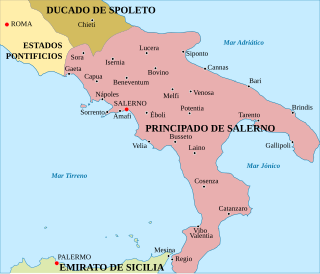
Guaimar IV was Prince of Salerno (1027–1052), Duke of Amalfi (1039–1052), Duke of Gaeta (1040–1041), and Prince of Capua (1038–1047) in Southern Italy over the period from 1027 to 1052. He was an important figure in the final phase of Byzantine authority in the Mezzogiorno and the commencement of Norman power. He was, according to Amatus of Montecassino, "more courageous than his father, more generous and more courteous; indeed he possessed all the qualities a layman should have—except that he took an excessive delight in women."

Pandulf I Ironhead was the Prince of Benevento and Capua from 943 until his death. He was made Duke of Spoleto and Camerino in 967 and succeeded as Prince of Salerno in 977 or 978. He was an important nobleman in the fight with the Byzantines and Saracens for control of the Mezzogiorno in the centuries after the collapse of Lombard and Carolingian authority on the Italian Peninsula. He established himself over almost the whole of the southern half of Italia before his death in March 981. He was an ancestor of Sancho I.

Pandulf IV was the Prince of Capua on three separate occasions.

The Duchy of Gaeta was an early medieval state centered on the coastal South Italian city of Gaeta. It began in the early ninth century as the local community began to grow autonomous as Byzantine power lagged in the Mediterranean and the peninsula due to Lombard and Saracen incursions.

The Duchy of Naples began as a Byzantine province that was constituted in the seventh century, in the reduced coastal lands that the Lombards had not conquered during their invasion of Italy in the sixth century. It was governed by a military commander (dux), and rapidly became a de facto independent state, lasting more than five centuries during the Early and High Middle Ages. Naples remains a significant metropolitan city in present-day Italy.
Richard Drengot was the count of Aversa (1049–1078), prince of Capua and duke of Gaeta (1064–1078).
Atenulf I, called the Great, was the prince of Capua from 7 January 887 and of Benevento from 899, when he conquered that principality. He also used the title princeps gentis Langobardorum: "prince of the Lombard people," an echo of the title used by the earliest prince of Benevento following the collapse of Lombard cohesion in 774.
Guaimar II was the Lombard prince of Salerno from 901, when his father retired to a monastery, to his death. His father was Guaimar I and his mother was Itta. He was associated with his father in the principality from 893. He was responsible for the rise of the principality: he restored the princely palace, built the palace church of San Pietro a campanile, and restored gold coinage.
Landulf II, called the Red, was the Lombard prince of Benevento and prince of Capua from 939 or 940, when his father, Landulf I, first associated him with the government. His mother was Gemma, daughter of Athanasius of Naples. He may have been associated as early as 933, when his elder brother, Atenulf III, was made co-regent. His uncle Atenulf II died in 940 and it is likely that Landulf served as a replacement. Landulf married Yvantia on an unknown date.
The Drengots were a Norman family of mercenaries, one of the first to head to Southern Italy to fight in the service of the Lombards. They became the most prominent family after the Hautevilles.
John III was the longest-reigning Duke of Naples (928–968). He was the son and successor of Marinus I.

The Principality of Salerno was a medieval Southern Italian state, formed in 851 out of the Principality of Benevento after a decade-long civil war. It was centred on the port city of Salerno. Although it owed allegiance at its foundation to the Carolingian emperor, it was de facto independent throughout its history and alternated its allegiance between the Carolingians and their successors in the West and the Byzantine emperors in the east.
Atenulf I was the Lombard count of Aquino who rose to become Duke of Gaeta in Southern Italy during the chaotic middle of the eleventh century.
Pandenulf was the Count of Capua, claiming that title from 862 and holding it successfully during the tumultuous civil war of 879 – 882. He was the son and successor of Pando, but was removed on his father's death by his uncle the bishop, Landulf II.

The Norman conquest of southern Italy lasted from 999 to 1194, involving many battles and independent conquerors. In 1130, the territories in southern Italy united as the Kingdom of Sicily, which included the island of Sicily, the southern third of the Italian Peninsula, the archipelago of Malta, and parts of North Africa.
The Landulfids or Atenulfings were a noble family of Lombardic origin in the ninth through eleventh centuries. They were descended from Landulf I of Capua, whose own ancestry is unknown and who died in 843. The dynasty produced a line of princes which ruled most of southern Italy at one time or another and even one pope, Victor III.

The Principality of Benevento was the sole Lombard territory which continued to exist as a rump state, maintaining its de facto independence after the fall of the Kingdom of the Lombards at the hands of the Franks. Benevento dwindled in size in the early 11th century, and was completely captured by the Norman Robert Guiscard in 1053.









